Tổng hợp đề thi IELTS Writing Task 1 dạng bài Process
Dạng bài Process trong bài thi IELTS Writing Task 1 được đánh giá khá khó vì thí sinh thường gặp khó khăn trong việc sử dụng đa dạng các ngữ pháp. Vậy bài viết này, TAK12 xin tổng hợp đề thi IELTS Writing theo các chủ đề Process như là nguồn tài liệu tham khảo giúp các thí sinh vượt qua bài thi cam go và đầy thử thách này.
1. Tổng quan về dạng đề Process
1.1: Process là gì?
Process (Quy trình) hoặc Diagram là một dạng bài trong Task 1 của phần thi IELTS Writing. Dạng bài Process yêu cầu thí sinh mô tả một quá trình hoặc quy trình nào đó theo biểu đồ hay hình vẽ cho trước.
Đề bài dạng bài Process thường yêu cầu:
- Viết một đoạn văn ít nhất 150 từ để miêu tả thông tin được cung cấp trong biểu đồ.
- Miêu tả biểu đồ một cách khách quan, không lồng vào quan điểm của người viết.
- Cần chọn lọc số liệu nổi bật để đưa vào bài. Sử dụng các ngôn ngữ, cấu trúc phù hợp, chuẩn xác.
1.2: Đặc điểm của Process?
Đặc điểm của dạng bài Process:
- Phải đề cập đến những thay đổi quan trọng trong quy trình.
- Không bỏ sót các bước. Có thể gộp các bước để viết.
- Không nên thể hiện quan điểm cá nhân trong bài.
1.3: Các dạng bài Process
Có hai loại bài tập nhỏ trong dạng này:
- Sơ đồ tự nhiên (natural process): bạn có thể gặp các đề bài như miêu tả chu trình sinh sản của loài ếch, miêu tả quá trình hình thành con bướm,…
- Sơ đồ nhân tạo (man-made process): quá trình sản xuất gạch ống, các giai đoạn sản xuất cà phê, đường,…
1.4: Các bước làm dạng bài Process
Trước tiên, người viết cần đặt ra hai câu hỏi sau trước khi vào làm bài chi tiết:
- Quá trình có bao nhiêu bước và trình tự ra sao?
- Đâu là điểm đầu – cuối của quá trình này?
- Lưu ý: Người viết cũng cần phải quan sát xem có xảy ra trường hợp trong hình có 2 hoạt động diễn ra cùng lúc hay không?
2. Các dạng đề Process đã ra những năm qua
2.1: Đề thi Process ngày 18/01/2018
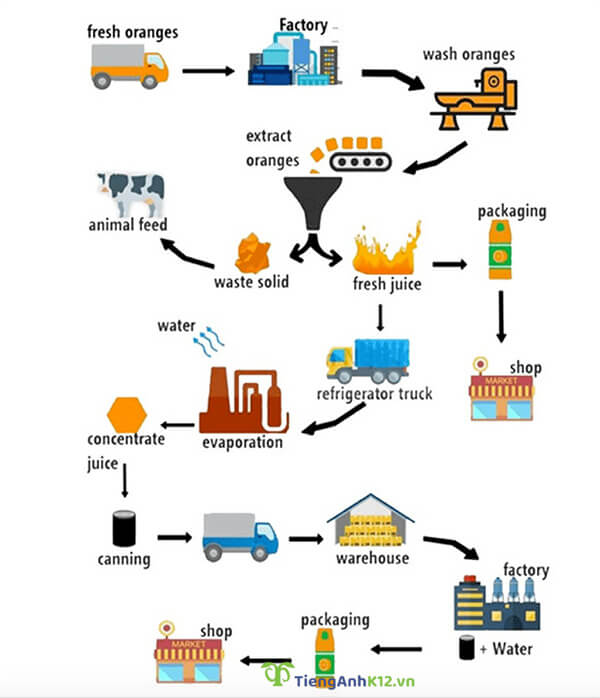
Đề bài: The diagram below shows how orange juice is produced
Bài tham khảo:
The diagram illustrates the process of producing of orange juice.
There are various stages in the process of making orange juice, beginning with the collection of fresh oranges and ending with the distribution of packaged juice to supermarkets.
Firstly, oranges are picked, loaded onto trucks, and delivered to a processing plant where they are thoroughly washed by a machine. Following this, the juice is extracted from the oranges by a squeezing machine, and the solid waste, including orange peels and seeds, is collected and used to feed animals. The squeezed juice can then either be packaged and sent to the supermarket, or transferred to another factory to undergo an evaporation process.
During the evaporation process, the fresh orange juice is processed by an evaporator machine where the water is removed. The concentrated juice is then canned and transported to a warehouse before being combined with water again. After that, it is packaged and distributed to supermarkets, ready to be purchased.
2.2: Đề thi Process ngày 10/08/2019
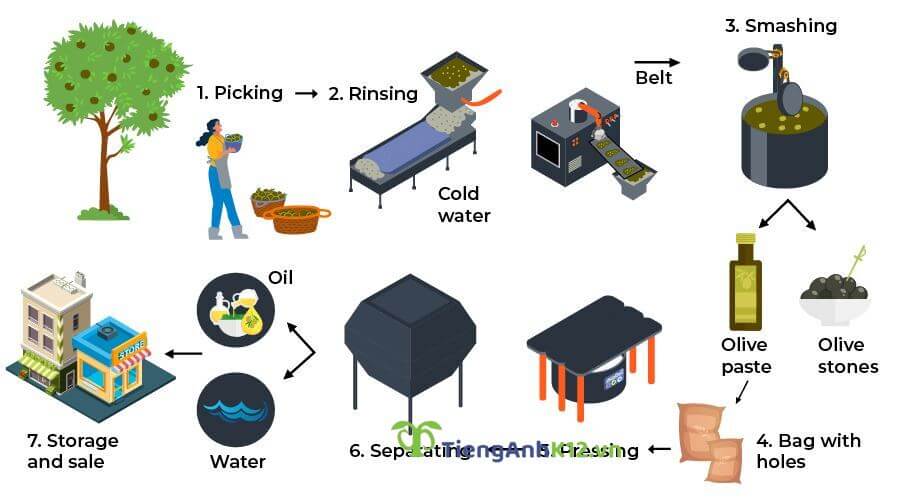
Đề bài: The diagram below shows the production of olive oil
Bài tham khảo:
The diagram illustrates the process by which olive oil is produced.
Overall, this is a step-by-step process that is comprised of seven stages, from the harvesting of the mature fruit from olive trees, to the packaging and sale of the finished product.
Initially, ripe olives are harvested from trees by farmers and then taken to a rinsing machine where they are washed in cold water. After being rinsed, the olives are transferred via conveyor belt to another machine which grinds the olives to separate the fruit from the seeds. During this stage, the olives are ground into a paste, and the olive stones are removed.
The olive paste is then placed in a type of perforated bag before being put through a pressing machine, followed by another process where any excess water is separated from the oil. And finally, the olive oil is packaged and delivered to shops where it can be sold.
2.3: Đề thi Process ngày 10/10/2020
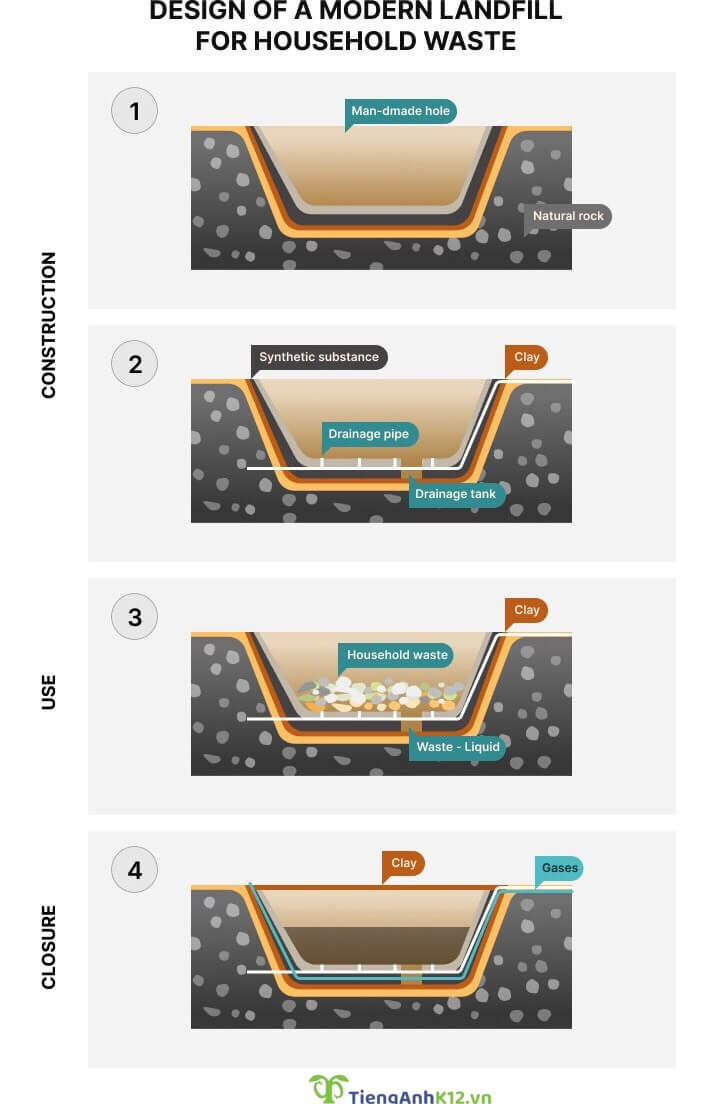
Đề bài: The diagram shows the design of a modern landfill for household waste.
Bài tham khảo:
The diagram shows the life cycle of a modern landfill used for the disposal of household waste. There are three main stages in the life of a landfill; the construction, the use of, and the closure.
Firstly, a giant hole is dug in the earth above a bed of natural rock. Once the hole has been dug, it is then lined with a thick layer of clay, followed by a layer of synthetic material which helps to stop toxic waste substances from leaching into the surrounding earth. Drainage pipes and a drainage tank are also installed in order to remove the toxic waste liquids from the bottom of the landfill.
Once the landfill has been built, it is ready to be filled with household waste. During the usage stage of the landfill, waste liquids will sink to the bottom where they will be held in the drainage tank and removed via the drainage pipes in order to minimise a build-up of gas. Once the landfill is full, it is covered with a thick layer of clay. As the waste degrades over time, waste gases are emitted from the landfill.
2.4: Đề thi Process ngày 05/09/2020
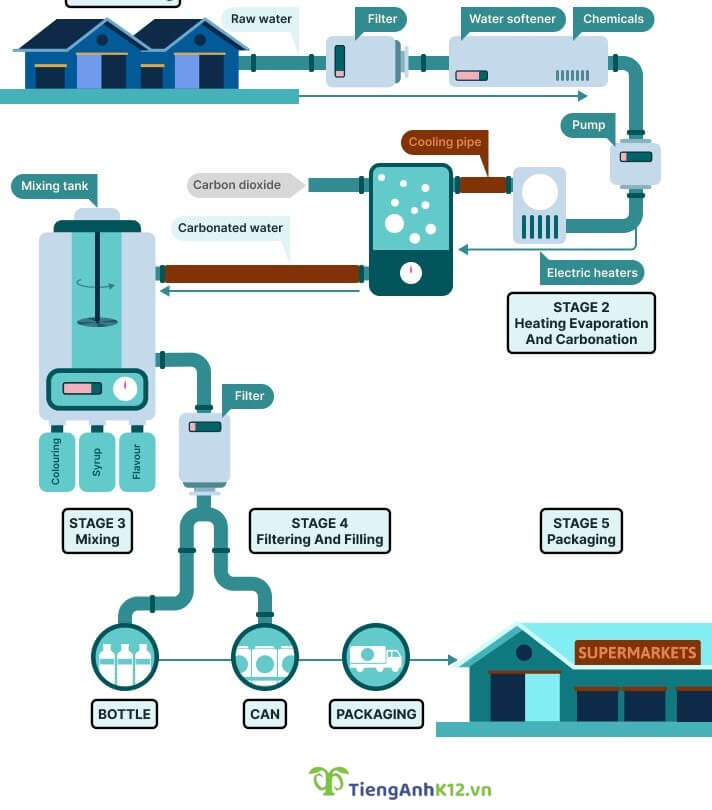
Đề bài: The diagram gives information about the process of making carbonated drinks. Summarise the information by selecting and reporting the main features, and make comparisons where relevant.
Bài tham khảo:
The diagram shows the stages involved in the production of soft drinks.
Overall, there are 5 stages in the process, beginning with preparing the water for the drinks, and culminating with the packaging and delivery of the finished product.
In the first stage of the process, water is put through a filter before a softener and other chemicals are added to it. Once the water has been processed, it is then pumped on to stage 2 where it undergoes evaporation and carbonation. During this stage, the water is heated and runs through a cooling pipe before carbon dioxide is added, creating carbonated water.
In the third stage of the process, the carbonated water is put into a mixing tank where it is mixed with colouring, flavouring, and sweetener. The resulting mixture is then filtered before being packaged into cans and bottles. Finally, once the bottles and cans have been packaged into boxes, they are transported to supermarkets where they are ready to be sold.
2.5: Đề thi Process ngày 18/12/2021
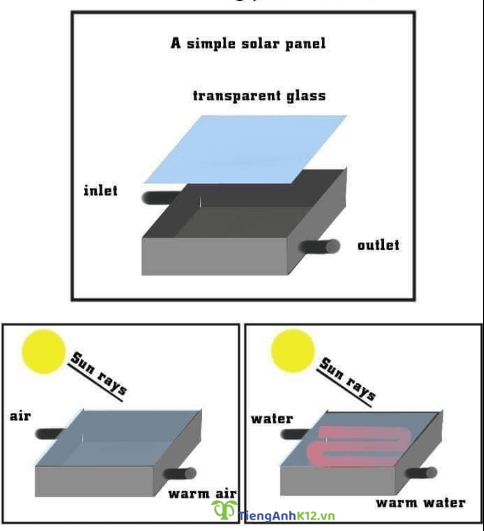
Đề bài: The diagram shows the structure of the solar panel and its use.
Bài tham khảo:
The diagrams illustrate the design of a simple solar panel and the process by which it generates energy.
Overall, the structure of the panel is not complex, consisting of only a few details. This structure enables the panel to utilize sunshine, which heats up either air or water.
To begin with, the layout of the panel is relatively simple. It is a rectangular container, with the surface layer made of transparent glass. In addition, there is an inlet and outlet on either side of the container, allowing water and air to flow through the system.
The energy generation process works by using solar power. Firstly, sun rays are absorbed by the transparent glass, thereby capturing the heat of these rays of sunlight inside the panel. This captured energy then turns air flowing through the system into warm air. Likewise, if the system contains water inside, it is also heated in a similar manner to air.
2.6: Đề thi Process ngày 06/08/2022
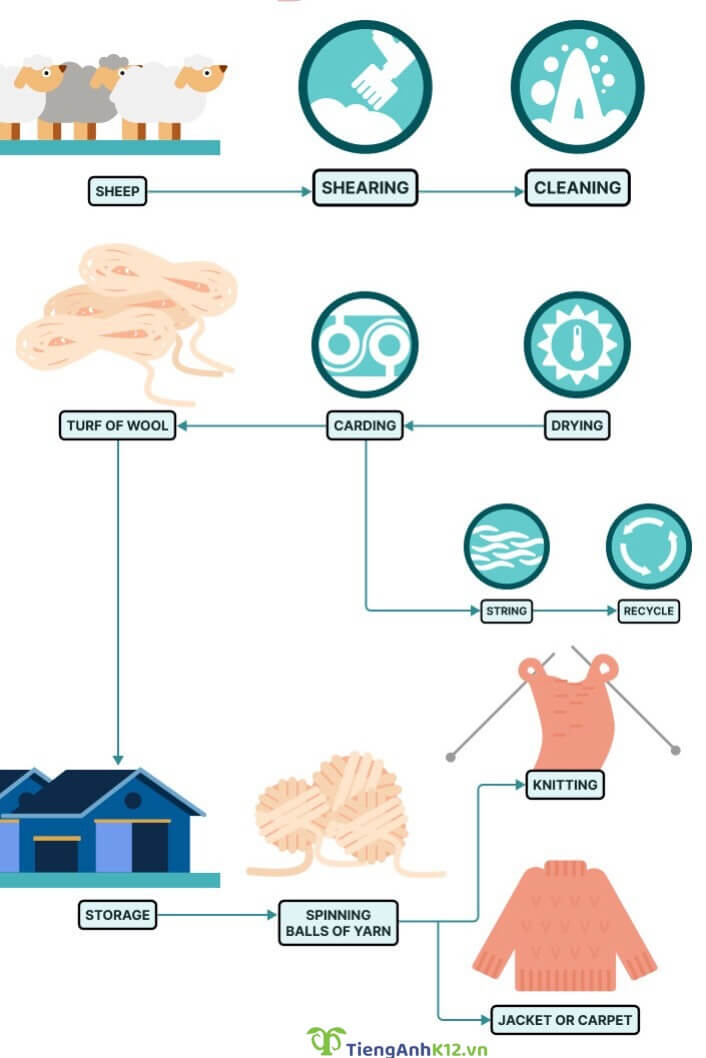
Đề bài: The picture shows the process of making wool.
Bài tham khảo:
The diagram illustrates the wool production procedure.
Overall, there are nine stages in the process of making wool, starting from sheep herding to using wool in knitting or making woolen products.
The first stage revolves around the collection of raw materials, in which the sheep are raised until they are matured enough to produce a thick layer of fur. The fur is then sheared and cleaned using water in order to remove dirt prior to the manufacturing stages. Having been clean, the wet fur is then transferred into a drying machine to soak up excess moisture. After that, the dried fur is carded with a wire instrument. This special tool brushes the wool straight and woven them into a single strand.
From this process, the wool is made into large turfs of wool, which would be put into storage, and the by-product - the discarded strings - will be recycled afterwards. In the final stage, the wool turfs are spun into balls of yarn which can either be used for knitting or for the production of woolen products such as jackets and carpets.
2.7: Đề thi Process ngày 30/04/2022
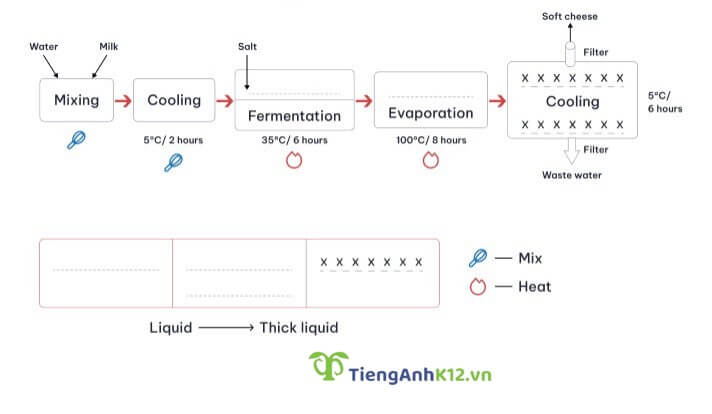
Đề bài: The diagram below shows the process of making soft cheese.
Bài tham khảo:
The flow chart illustrates the production of soft cheese.
Overall, it can be seen that there are 5 stages in the process of making soft cheese, starting from mixing ingredients to the finished products that are ready to be consumed.
In the first stage, two main components namely water and milk are mixed together. After that, the mixture is cooled for 2 hours at a temperature of 5 Celsius degrees. Then, an amount of salt is added to the mixture before it undergoes the constant fermentation process which lasts for 6 hours.
The next stage requires the liquid to evaporate, which let off its steam through a channel. After 8 hours of being under the heat of 100 Celcius degree, the mixture becomes thicker. In a final step, which happens for 6 hours, this mixture is stored in a cooling space where wastewater and the finished soft cheese are filtered.
3. Các từ vựng trong các bài mẫu trên
- the disposal of household waste: việc thải các chất thải sinh hoạt
- a giant hole: một cái lỗ khổng lồ
- a bed of natural rock: nền đá tự nhiên
- to be lined with something: được lót bằng vật gì đó
- toxic waste substances: các chất thải độc hại
- to leach into: len lỏi vào
- drainage pipes and a drainage tank: ống thoát và bể thoát chất thải
- to sink to the bottom: chìm xuống đáy
- to minimise a build-up of gas: tối thiểu hoá sự tích tụ khí
- to degrade over time: suy giảm theo thời gian
- to be emitted: được phóng ra (khí)
- a filter: máy lọc nước
- a softener: chất làm mềm nước cứng
- evaporation: quá trình bay hơi
- carbonation: quá trình carbonate hoá dung dịch (thêm carbon dioxide vào chất lỏng)
- resulting mixture: hỗn hợp được tạo ra
- design (n.): thiết kế
- consisting of (v.): bao gồm
- utilize (v.): tận dụng
- rectangular (adj.) hình chữ nhật
- surface (n.): bề mặt
- absorb (v.) hấp thụ
- capture (v.) giữ
- flowing through (phr.v.): chảy qua
Trên đây là toàn bộ tổng hợp của TAK12 về dạng đề thi IELTS Writing Process. Hy vọng bài viết trên giúp các bạn hiểu được cách làm và cách thức ra đề của dạng bài này.
[%Included.IELTS%]